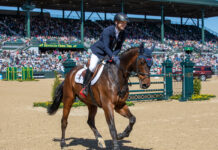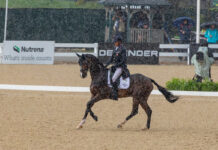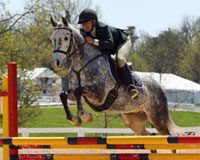Haunches-in (or travers) is the most advanced way to teach your horse inside bend. For a correct haunches-in, your horse must move with his front legs and shoulders on the track and his haunches off the track. It isn’t the easiest maneuver to master so keep things simple by breaking it down into steps.
Your Position
- Sit facing straight ahead with your shoulders aligned with your horse’s shoulders.
- Keep your inside leg at the girth (calf supports the bend and keeps the horse at the track) and your outside leg behind the girth (pressure from your calf asks the haunches to swing in).
- Outside rein helps keep the horse’s neck straight and inside rein asks for a slight flexion to the inside.
- Keep more weight on the inside sitting bone.
Your Horse’s Position
- Your horse’s neck and shoulders should be parallel to the long side.
- The rest of his body should be bent to the inside.
Top Three Mistakes in Riding Haunches-In
Solution: Horses often lean to the wall so ask for the haunches-in on the centerline or quarterline instead. He also may not understand what you are asking for. Review your basics and make sure he responds to your lateral aids.
2. You get a lot of neck bend without much haunches-in.
Solution: This is caused when a rider uses her reins in place of proper leg aids. Check your aids, make sure you are asking properly and try again. Remember to keep the neck and shoulders straight.
3.You have trouble maintaining the bend.
Solution: Start the haunches-in from a circle to create the bend and then go straight ahead in haunches-in. Go back to the circle if you lose your bend.
Further Reading
Developing Shoulder-in
The Shoulder-Fore: Shoulder-in Training Wheels
Award-winning author Sharon Biggs is a freelance writer in England.






It’s very intersting that you are told how to start Haunches in, but very rarely told how they should be completed, and why. i.e. bring the shoulders back in front of the haunches or just put the haunches back in behind the shoulders and ride on….
I can’t wait to try this on my horse. Thanks so much!
good tips
great info.
I agree with Leah. This is a reasonably advanced movement and while the article covers the bare bones of the “how” it doesn’t even begin to touch on the “why”. Not to mention it says nothing about the prerequisites for this movement.
HI isn’t discipline specific, and I get that the articles aren’t designed for experienced riders, but giving half-way advice to riders who aren’t prepared to execute the movement is kind of pointless.
Great info!
Thank you
Thanks
Thanks